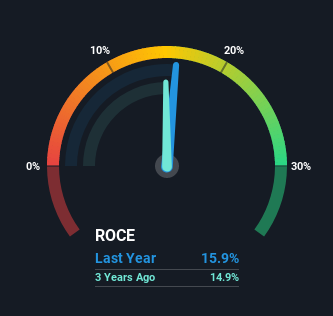Capital (LON:CAPD) Might Have The Makings Of A Multi-Bagger
If you're not sure where to start when looking for the next multi-bagger, there are a few key trends you should keep an eye out for. One common approach is to try and find a company with returns on capital employed (ROCE) that are increasing, in conjunction with a growing amount of capital employed. This shows us that it's a compounding machine, able to continually reinvest its earnings back into the business and generate higher returns. With that in mind, we've noticed some promising trends at Capital (LON:CAPD) so let's look a bit deeper.
What is Return On Capital Employed (ROCE)?
Just to clarify if you're unsure, ROCE is a metric for evaluating how much pre-tax income (in percentage terms) a company earns on the capital invested in its business. The formula for this calculation on Capital is:
Return on Capital Employed = Earnings Before Interest and Tax (EBIT) ÷ (Total Assets - Current Liabilities)
0.16 = US$33m ÷ (US$272m - US$62m) (Based on the trailing twelve months to June 2021).
So, Capital has an ROCE of 16%. In absolute terms, that's a satisfactory return, but compared to the Energy Services industry average of 5.3% it's much better.
Check out our latest analysis for Capital
In the above chart we have measured Capital's prior ROCE against its prior performance, but the future is arguably more important. If you're interested, you can view the analysts predictions in our free report on analyst forecasts for the company.
What Can We Tell From Capital's ROCE Trend?
Capital has recently broken into profitability so their prior investments seem to be paying off. Shareholders would no doubt be pleased with this because the business was loss-making five years ago but is is now generating 16% on its capital. And unsurprisingly, like most companies trying to break into the black, Capital is utilizing 160% more capital than it was five years ago. We like this trend, because it tells us the company has profitable reinvestment opportunities available to it, and if it continues going forward that can lead to a multi-bagger performance.
In Conclusion...
To the delight of most shareholders, Capital has now broken into profitability. And investors seem to expect more of this going forward, since the stock has rewarded shareholders with a 94% return over the last five years. With that being said, we still think the promising fundamentals mean the company deserves some further due diligence.
If you'd like to know more about Capital, we've spotted 4 warning signs, and 2 of them don't sit too well with us.
For those who like to invest in solid companies, check out this free list of companies with solid balance sheets and high returns on equity.
This article by Simply Wall St is general in nature. We provide commentary based on historical data and analyst forecasts only using an unbiased methodology and our articles are not intended to be financial advice. It does not constitute a recommendation to buy or sell any stock, and does not take account of your objectives, or your financial situation. We aim to bring you long-term focused analysis driven by fundamental data. Note that our analysis may not factor in the latest price-sensitive company announcements or qualitative material. Simply Wall St has no position in any stocks mentioned.
Have feedback on this article? Concerned about the content? Get in touch with us directly. Alternatively, email editorial-team (at) simplywallst.com.

